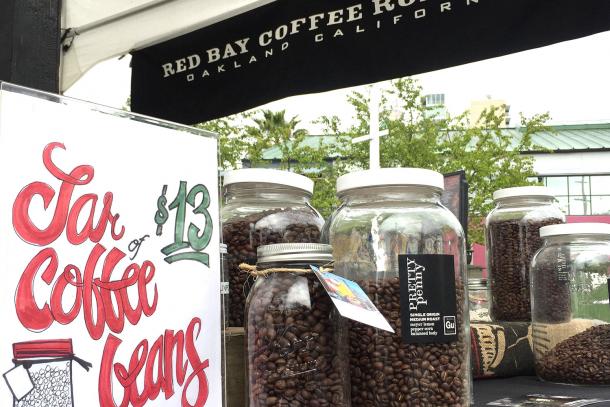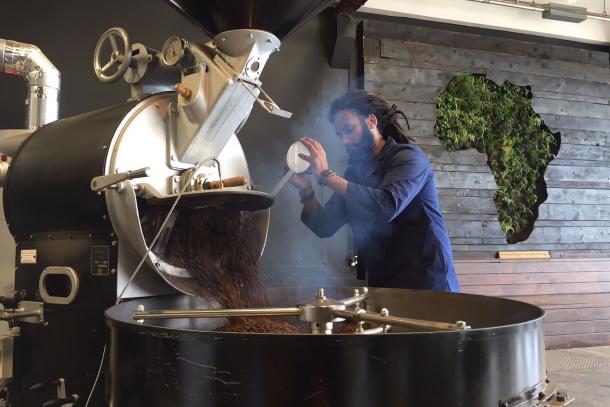Red Bay Creates Community through Beautiful Coffee
Brie Mazurek, CUESA Staff
April 28, 2017

Coffee has a complicated global path from farm to cup. Oakland’s Red Bay Coffee aims to demystify that path and make coffee a vehicle for connection, social justice, and economic empowerment.
 With a background as an artist and activist, Bay Area native Keba Konte co-founded Guerilla Café in North Berkeley in 2005, sourcing coffee from Blue Bottle and produce from local farms, while building a young and diverse workforce. In 2012, he expanded that concept to San Francisco, starting Chasing Lions Café on the CCSF campus.
With a background as an artist and activist, Bay Area native Keba Konte co-founded Guerilla Café in North Berkeley in 2005, sourcing coffee from Blue Bottle and produce from local farms, while building a young and diverse workforce. In 2012, he expanded that concept to San Francisco, starting Chasing Lions Café on the CCSF campus.
Next, Keba decided to apply his experience as a barista, maker, and entrepreneur to building a roastery in Oakland, with a focus on social justice and creating good jobs for Oakland residents. He took classes, watched YouTube videos, and built a coffee lab in his garage, where he honed his skills roasting small batches of beans to perfection. With the help of a crowdfunding campaign, he launched Red Bay Coffee in 2014. The company is now 17 employees strong, with a roastery-warehouse in Fruitvale, a shipping container café in Uptown Oakland, and growing retail distribution.
Most recently, Red Bay added Jack London Square Farmers Market to their roster of locations. We talked with Keba about Red Bay’s vision for making expertly roasted coffee equitable, sustainable, and delicious for all.
What led you to found Red Bay Coffee?
I launched Red Bay with a mission to bring beautiful coffee to the people. What I mean by that is that I really wanted to open up the specialty coffee industry to folks who have barriers to entry. I wanted to bring more diversity and inclusion to the industry, like I did with Guerilla Café and Chasing Lions. Red Bay Coffee is a culmination of that work. Even as an artist, I was a community organizer and activist, so social justice has always been something that was important to me and to my family. I also wanted to make coffee a lot more accessible to the public and create welcoming spaces for people who don’t know anything about specialty coffee.

People don’t always think about where coffee comes from, and how it gets from the farm to the cup. In terms of social justice, how are you thinking about that global distribution chain?
Coffee is a global commodity, and there are a lot of people involved. A single cup of coffee has gone through so many hands and processes, so when you get a decent cup, it’s a phenomenon—so many things really had to go right. I would also say that coffee is an industry that has been notorious for exploitation. A lot of people have been exploited around the world for commodities such as coffee and sugar for centuries—slavery, quite frankly. Now that coffee has reached this gourmet level of fetish, and people are paying a really high price for it, I think about the people who are really breaking their backs growing their coffee. That’s something I really care about.
The specialty coffee industry has developed some innovative practices to bring more value or equity to the farmers. For example, we practice direct trade at Red Bay, which puts more money in the farmers’ pockets. But when you look at where coffee is grown, in Africa, Central America, South America, and Southeast Asia, the people who are growing coffee and the descendants of those farmers are poorly represented in the rest of the specialty coffee industry. After it leaves the farm from export to import to grocers to coffee shops to the equipment makers to vendors, it’s a huge multibillion-dollar industry. The movement to create more inclusion and diversity bridges the gap.

How does inclusion fit into Red Bay’s business model and employee practices?
The question I had to ask myself is, “What are we doing as an industry to bring more equity to the baristas and other workers on this side of the industry, no matter what color they are?” For example, through companywide profit-sharing incentives, our employees share 10% of the profits we make, which is about equity here in the Bay Area, where gentrification is really rampant. As an entrepreneur, one role I can play is helping people stay, and the way I can do it is by trying to provide livable wage jobs.
Also, there are folks who have been locked out of a lot of industries and are deserving of a second chance. We’ve intentionally hired many formerly incarcerated employees, who have served as baristas and coffee roasters, from management level to production workers. We also work with foster youth and aged-out foster youth, who are now part of the Red Bay family.
Specialty coffee can be intimidating. How does your work at Red Bay help to make it more approachable and inclusive?
We are very intentional in training our frontline staff to keep it light and fun, and not take ourselves too seriously. We also do free public cuppings and tours at our warehouse. We have a lot people who are first-time coffee drinkers. We’ve converted people who were not interested in coffee because of the culture around it. And even people who drink regular coffee, who don’t know that there is a difference between coffees, they start tasting the single-origin Sumatra as opposed to a blend, trying them side by side and noticing how dramatic the flavors and profiles can be.

What are your go-to Red Bay coffees that you recommend to people?
Ethiopia is the birthplace of coffee. It has the most variety of coffee than any other origin on the planet. We have a medium-roast Ethiopian coffee we call King’s Prize that might be my go-to. Also, East Fourteenth, which is a darker roast. Those are a couple winners that will always make people happy.
Can you tell us about the artwork associated with each coffee?
The artwork is street art from the countries where the coffee is from, such as Rwanda, Colombia, Tanzania. That’s a lot of fun to see. It broadens people’s perspectives about that origin country and provides context. I think it’s important to take people off the farm and into the communities.
What’s next for Red Bay?
We’re opening a café inside of our headquarters in Fruitvale this summer. We’re also building a beautiful aquaponic garden across the street, where people can take their drinks and sit next to the train tracks. I have an aquaponic garden in my yard, and I really enjoy introducing it to people. When they see it for the first time and they get the concept, it’s such a mind blow. In this time of water scarcity, it’s an important lesson in the cyclical nature of the universe.

People talk about the current specialty coffee movement as a “third wave.” What’s your vision for the fourth wave?
I think that the fourth wave of coffee is not just about what we do, but it’s about how we do it, who we do it with, and the impact on the community and the environment. What’s happening at the roastery and café level is kind of tapped out in terms of innovation. I’d say the next movement in coffee on a technical level is going to happen on the farm, where there are some really interesting things happening that are going to have the greatest impact on cup of coffee. But in the overall industry, I think fourth wave is about us coming together and using this multibillion-dollar platform to raise our communities up and share more.
Find Red Bay Coffee selling freshly brewed cups and coffee beans at Jack London Square Farmers Market on Sundays.
Photos courtesy of Red Bay Coffee.
Topics: Entrepreneurship, Small business
